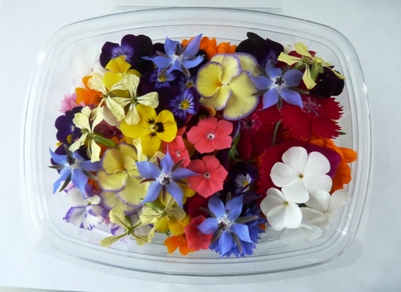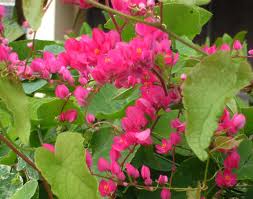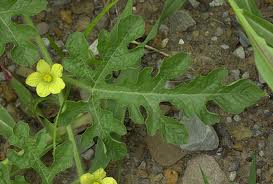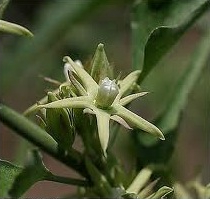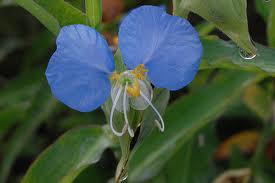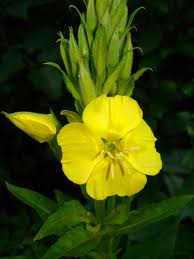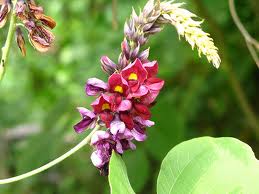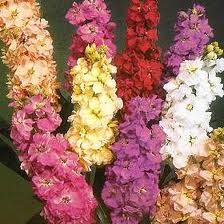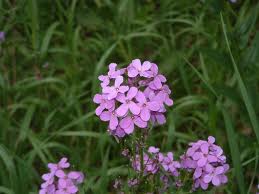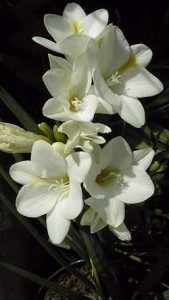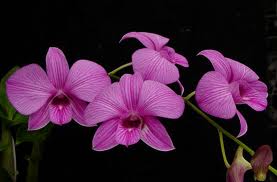Coral Vine, Citron Melon, Milkweed Vine, Dayflower, Evening Primrose, Kudzu, Stock, Dame’s Rocket, Freesia, Dendrobium phalaenopsis
The Coral Vine has dozens of names, not only as a cultivated blossom but an escapee on the most noxious list. Botanically it is Antigonon leptopus. A native of Mexico it has edible roots, leaves and for this series, flowers. To read more about it go here. The vine can climb to some 40 feet and blossoms nearly year round in warm area. Butterflies and bees like it (you’ve been warned) because over 40% of its blossoms are open at a time. The blossoms, like the leaves and roots, have to be cooked. The roots, while edible, are hard to find and dig up.
The two plants non-foraging people ask about all the time are Society Garlic (covered elsewhere) and those small watermelon like fruit seen in old citrus groves and abandoned fields. The short answer is they are Citron Melons. They used to be cultivated for to make preserves and I have a separate article about that here. However, their blossoms are edible if they are not bitter. The blossoms should be cooked though usually one never sees the plant until the late fall and winter when one can see the fruit from the seasonal die back. The blossom might be edible raw, I just haven’t tired them.
By looking at the names of this vine and the attitude of the state of Florida one would never suspect most of it is edible including the flowers. It’s called the Milkweed Vine, the Latex Vine, the Strangler Vine, the latter because it tends to climb on trees and cover them. Botanically it is Morrenia odorata. Literally from the ground up this plant is edible and the fruit has more Vitamin C than citrus (an industry that fights to get rid of it.) The flowers are very sweet and floral and can be eaten raw. This vine is only found in warm areas. Don’t try confuse it with the cool climate Honeyvine, Cynanchum laeve, which is not edible. Also Hemp Vine (Mikania Scandens) before it blossom looks vaguely similar as well.
My love affair with Dayflowers is over. They don’t like me anymore. Well, the raw stems don’t. The raw blossom still do. In the Commelina clan there’s quite a few of them and while the blossoms are fine to toss in a salad, candy or use as a garnish — just like their relative the Spiderworts, I am beginning to think the stems and older leaves are overrated. Raw they irritate my tummy these days. The blossoms can vary in size depending on which species and can have three blue petals, two blue petals and one small white petal or two large blue petals and one smaller blue petal. Their flavor is an inoffensive green. The Yellow Commelina, Commelina africana, is edible cooked. They both are closely related to the tiny Doveweed.
Every climate has its good and bad points and one of the bad points locally is that the tall, northern Evening Primrose does not grow here. I think the the most amazing specimen I ever saw was in Vathia, Greece (Vathis is literally the end of the road on the central peninsula of southern Greece, deep in The Mani.) The Evening Primerose was at least six feet tall and totally covered with flowers. Here in Florida we have a very scraggly ground hugging one. I have not tired its flowers. On my list of things to do. However, the common Evening Primrose of northern climes does have edible blossoms. They are sweet and can be used in a variety of ways raw or cooked if you prefer, salad to soups to garnish. They can even be pickled.
You never have to go looking for kudzu blossoms. When kudzu is in bloom there is no mistaking its scent. It is smells exactly like the cheap grape bubble gum kids chew. And intense? You can detected it on the wind from 100 yards away, or more. Kudzu is the bane of the Old South. Introduced by the government which paid farmers to use it for land reclamation, it can grow a foot a day and covers some 120,000 new acres every year. Goats love to eat it and all of it is edible except the seeds. The blossoms are quite edible recipes abound in their use, jelly to wine. While the smell like grape they do not taste like grape. They are sweet and have a flavor of their own.
Some like it hot, and some do not, and Stock does not. It’s a fragrant, two-foot tall, attractive flower that likes full sun, good, well-drained soil, and temperatures under 75 F°. They can even tolerate a light frost. There are some 140 species of Stock. The one we are interested in is Matthiola incana, common stock as it were though it comes in many colors. It’s native along the Mediterranean from Greece to Spain and was a mainstay of European gardens in the 16th and 17th centuries. The Elizabethans called them “gillyflower” and the Victorian allowed them in their cottage gardens. Even Thomas Jefferson got some for Monticello in 1771 and in fact one can still buy seed from Jefferson’s stock…of Stock. Stock flowers are usually added to salads raw or a garnish to sweet desserts. They can be candied. Their flavor is perfume-ish. The plant’s pods are edible as well. A common cultivated flower in North American it is naturalized in North Carolina, Illinois, Texas, California and British Columbia usually in a few isolated areas but rather well-distributed in coastal southern California and San Francisco. It is also called Tenweeks Stock.
Dame’s Rocket is a declared invasive species in several places. It’s your civic duty eat the weed. Originally from Eurasia some 400 years ago it’s a mustard that at first glance looks like Phlox. Dame’s Rocket has the typical mustard family four petals, Phlox, five. It’s found essentially everywhere in North America except the Old South. Botanically known as Hesperis matronalis, it is cultivated, escaped and is included in wild bird seed mix. Young leave collected before flowering are eaten like cress. Seed pods can be added stews and soups. Seeds are a source of oil and can be sprouted and eaten. The flowers are used to add spicy flavors to fruit dishes and salads.
As a forager one of the first things you learn is that there isn’t much to offer in the Iris family, or, if it is an Iris beware. Freesia is an exception. A native of South Africa and Australia, it’s an Iris to about 18 inches tall and grows from a bulb. The stem branches once giving it a classic Y shape. One odd thing about the Freesia is that they grow in a helicoid, that is the flowers attach to the stem in a spiral fashion but they all point the same way. Fragrance varies with the variety. And the usual debate is whether it’s a wild plant as it is in its native range or a cultivated plant as most of these readers will find it. I opted for cultivated. So far I have put only one flower in both wild and cultivated and that’s Dame’s Rocket. Freesias colors include white, purple, yellow, orange and red. In the language of flowers they represent “innocence.” The highly scented blossoms are used in salads raw or as a garnish. They are reported to be excellent infused with a sugar syrup, and are used in sorbets for flavoring.
If you go to a Thai restaurant often a Dendrobium phalaenopsis is put on your plate. No that not a creature, it’s an orchid unfortunately without a common name in English. Said Den-DROH-be-um fal-en-NOP-siss their flavor is light, if any, but they are pretty with a crisp texture. This also brings up the debate if all orchids are edible. Personally I think that is impossible for one person to say as there are more than 20,000 of them, maybe 26,000, in some 800 genera. Many do have edible roots. Edible flower information is sketchy. One would like to think orchids used as garnishes would be edible just to avoid liability. However garnish writers seem to skip over issues of orchid edibility. Kind of like writing about flying and leaving out the airplane. Dendrobium phalaenopsis comes in a variety of colors and are native to southeast Asia. They are not difficult to grow. Use in salads and as a garnish.

